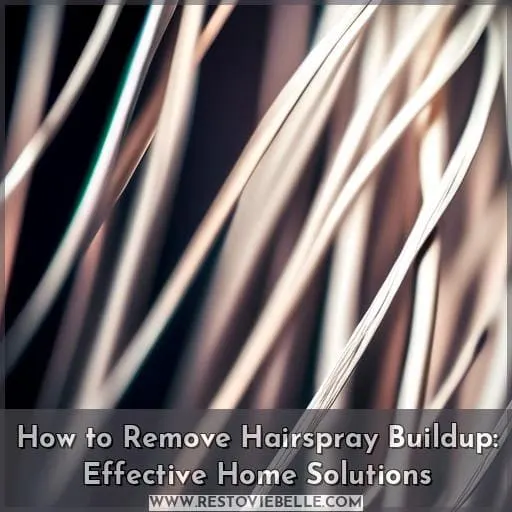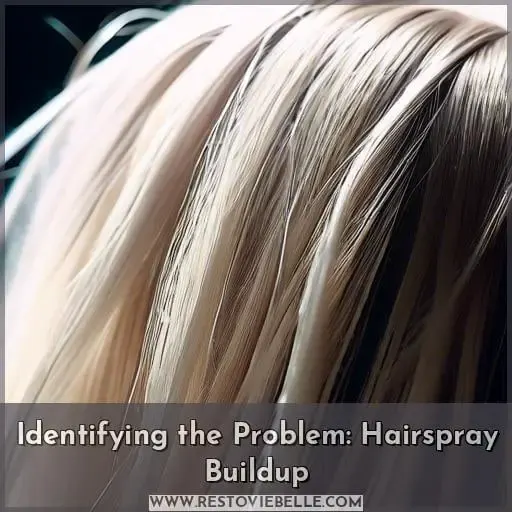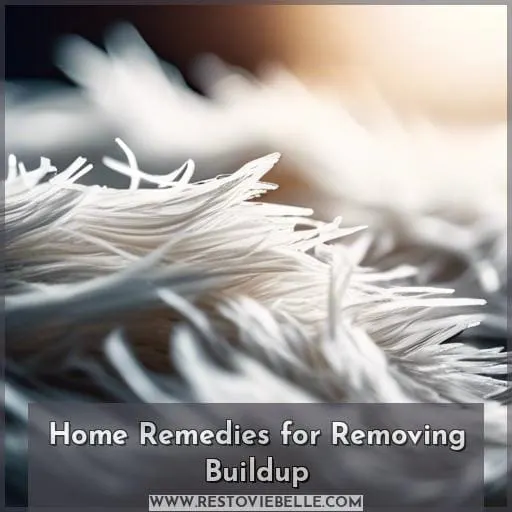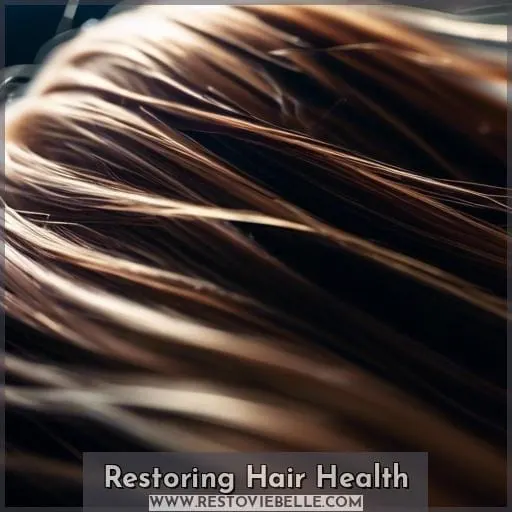This site is supported by our readers. We may earn a commission, at no cost to you, if you purchase through links.
 Struggling with hairspray buildup in your hair? You’re not alone. This common issue can leave your locks looking dull and lifeless, but fear not! Our guide on how to remove hairspray buildup offers effective home solutions that promise to restore your hair’s natural shine and bounce.
Struggling with hairspray buildup in your hair? You’re not alone. This common issue can leave your locks looking dull and lifeless, but fear not! Our guide on how to remove hairspray buildup offers effective home solutions that promise to restore your hair’s natural shine and bounce.
From the simplicity of a baking soda mixture to the natural potency of an apple cider vinegar rinse, and even a dish soap solution, we’ve got you covered.
Dive into our step-by-step application techniques, learn how to prevent future buildup, and discover how to rejuvenate your hair with deep conditioning treatments and protective care practices.
Say goodbye to buildup and hello to healthier, more vibrant hair.
Yes, to get hairspray buildup out of hair, you can use a mixture of shampoo and baking soda, a clarifying shampoo, or a home remedy like apple cider vinegar or dish soap. These methods help break down the hairspray, allowing it to be washed out, restoring hair’s shine and health.
Table Of Contents
- Key Takeaways
- Identifying the Problem: Hairspray Buildup
- Home Remedies for Removing Buildup
- Application Techniques
- Preventing Future Buildup
- Restoring Hair Health
- Frequently Asked Questions (FAQs)
- Can hairspray buildup cause allergic reactions or skin irritation on the scalp?
- How often should I use a clarifying shampoo if I frequently use hairspray?
- Are there any salon treatments specifically designed to remove hairspray buildup?
- Can certain hair types, like color-treated or fine hair, be more susceptible to damage from hairspray buildup?
- Is it safe to use home remedies like baking soda or vinegar on dyed or bleached hair to remove hairspray buildup?
- Conclusion
Key Takeaways
- Utilize a baking soda mixture (1 part baking soda to 3 parts water) or add a teaspoon of baking soda to your regular shampoo to effectively break down hairspray buildup and restore hair’s natural shine.
- Apple cider vinegar rinse (1 part vinegar to 2 parts water) can be used as a natural remedy to remove residue and improve hair health.
- For a more potent solution, dish soap mixed with water can be applied to the hair to cut through the buildup, but it should be used cautiously, especially on color-treated hair, due to its strong detergents.
- To prevent future buildup and maintain hair health, reduce the frequency and amount of hairspray application, use clarifying shampoos regularly, and incorporate deep conditioning treatments into your hair care routine.
Identifying the Problem: Hairspray Buildup
You’ve likely noticed your hair feeling heavy, dull, and difficult to manage. This is often due to hairspray buildup, a common issue for those who frequently use styling products.
Over time, layers of hairspray can accumulate on your hair and scalp, leading to damage prevention challenges, scalp irritation, and even hair breakage.
Understanding the root cause—your styling habits—opens the door to finding effective product alternatives and solutions. By addressing hairspray buildup, you’re not just tackling a temporary inconvenience; you’re taking a significant step towards healthier hair and scalp.
Home Remedies for Removing Buildup
Hairspray buildup can leave your hair feeling heavy, dull, and lifeless, but don’t worry, there are simple home remedies to tackle this issue.
You can use a baking soda mixture, an apple cider vinegar rinse, or even a dish soap solution to effectively remove the buildup and restore your hair’s natural shine and bounce.
These ingredients work by breaking down the hairspray residue, allowing you to wash it away and bring back the health and luster of your hair.
Baking Soda Mixture
To effectively remove hairspray residue, try a baking soda mixture. This gentle yet powerful solution combats product buildup without causing scalp irritation, promoting hair rejuvenation.
- Combine 1 part baking soda with 3 parts water.
- Apply to damp hair, massaging into the scalp.
- Let sit for a few minutes.
- Rinse thoroughly, enjoying a refreshed feeling.
Apple Cider Vinegar Rinse
After exploring the benefits of a baking soda mixture, let’s dive into another effective home remedy for removing hairspray buildup: the apple cider vinegar rinse. This natural solution can enhance your hair’s shine and manageability. The acetic acid in apple cider vinegar helps balance your hair and scalp pH, potentially preventing scalp infections and itchiness.
For optimal results, consider the timing and frequency of application, as well as the dilution ratio to suit your hair type.
| Step | Description | Tips |
|---|---|---|
| 1 | Mix apple cider vinegar with water | Use a dilution of 1 part vinegar to 2 parts water |
| 2 | Apply after shampooing | Pour the mixture over your hair, massaging into the scalp |
| 3 | Rinse thoroughly | Wait a few minutes before rinsing to allow the vinegar to break down buildup |
Experiment with variations, like adding essential oils, to find the perfect balance for your hair. With regular use, you’ll notice the benefits of softer, cleaner hair without the harsh chemicals.
Dish Soap Solution
After exploring the benefits of an apple cider vinegar rinse, let’s delve into another effective remedy for hairspray buildup: the dish soap solution.
Dish soap, known for its grease-cutting properties, can be a potent ingredient for tackling stubborn residue in your hair. When using this method, it’s crucial to consider the ingredient ratio to avoid over-drying, especially if you have a sensitive scalp or specific hair type.
A small amount of dish soap mixed with water can create a solution that, when applied to your hair, breaks down the buildup without causing irritation.
Application Techniques
When tackling the challenge of removing hairspray buildup from your hair, it’s essential to approach the task with the right techniques and a bit of know-how.
Mixing your regular shampoo with ingredients like baking soda can create a potent mixture that breaks down the buildup effectively.
Additionally, employing rinsing and washing methods, such as using a clarifying shampoo or an apple cider vinegar rinse, can further cleanse your hair, restoring its natural shine and health.
These strategies are straightforward yet highly effective in combating the dullness and heaviness caused by hairspray residue.
Mixing With Shampoo
Mixing your regular shampoo with a bit of baking soda is a clever trick for tackling hairspray buildup.
Start by diluting your shampoo’s concentration with a teaspoon of baking soda, creating a potent mixture tailored for deep cleansing.
Before applying, consider your hair type and any scalp sensitivity to ensure the blend is just right for you.
Gently massage this pre-shampoo concoction into your hair, focusing on areas with the most buildup.
The leave-in duration shouldn’t be long—just enough to break down the residues without irritating your scalp.
This method not only purifies your hair but also respects its natural balance, paving the way for healthier, buildup-free locks.
Rinsing and Washing Methods
After applying your chosen home remedy for hairspray buildup, it’s crucial to follow effective rinsing and washing methods to ensure all residue is removed.
- Rinse timing: Spend ample time rinsing your hair to ensure no baking soda, apple cider vinegar, or dish soap solution is left behind. A thorough rinse is key to removing all traces of buildup.
- Water temperature: Use warm water to open the hair cuticles for effective cleansing, then finish with a cold water rinse to seal in moisture and enhance shine.
- Drying techniques: Avoid rubbing your hair with a towel as this can cause frizz. Opt for air-drying or use a soft T-shirt or microfiber towel to gently blot your hair dry.
Incorporate gentle brushing to detangle without causing damage and apply a leave-in conditioner to nourish and protect your hair.
Preventing Future Buildup
To prevent future buildup from hairspray, it’s essential to adjust how you use it and establish regular cleansing routines.
By being mindful of the amount and frequency of hairspray application, you can maintain your hair’s health and avoid residue accumulation.
Incorporating thorough cleansing methods, such as using clarifying shampoos or home remedies, ensures that any buildup is effectively removed, keeping your hair looking fresh and vibrant.
Adjusting Hairspray Use
After mastering the removal techniques, you’ll want to prevent future buildup. Start by reducing your hairspray application; a light touch is often enough. Consider alternating with other products that offer hold without heavy residues.
| Use Less | Use Alternates |
|---|---|
| Spray once, not twice | Mousse or gel |
| Hold can farther away | Light-hold sprays |
| Target specific areas | Styling creams |
| Opt for natural hold | Texturizing sprays |
Regular Cleansing Routines
After adjusting your hairspray use, it’s crucial to establish regular cleansing routines to prevent future buildup.
- Frequency of Cleansing: Depending on your hair type, cleansing frequency can vary. However, incorporating a clarifying shampoo into your routine at least once a month can effectively remove any lingering residue.
- Scalp Irritation: To avoid irritation, choose products that are compatible with your scalp. If you have sensitive skin, look for gentle, sulfate-free options.
- Conditioner Usage: Always follow up with a conditioner after using clarifying shampoos to replenish moisture and protect your hair from drying out.
- Product Compatibility: Pay attention to the ingredients in your hair care products. Avoid those with heavy oils or silicones that can contribute to buildup.
By adopting these practices, you’ll not only prevent buildup but also promote healthier, more vibrant hair.
Restoring Hair Health
To restore your hair’s health after dealing with hairspray buildup, consider incorporating deep conditioning treatments into your routine. These treatments can help revitalize and hydrate your hair, addressing the dryness and damage that styling products may cause.
Additionally, adopting protective hair care practices, such as using the right products for your hair type and avoiding harsh chemicals, can prevent further damage and maintain your hair’s natural luster.
Deep Conditioning Treatments
After addressing how to prevent future buildup, it’s crucial to focus on restoring your hair’s health.
Deep conditioning treatments are your best ally in this journey. These treatments, including hair masks, moisturizing treatments, nourishing oils, and leave-in conditioners, are designed to penetrate deeply into your hair fibers, providing intense hydration and repair.
By incorporating these into your routine, you’ll not only combat the effects of hairspray buildup but also enhance your hair’s overall health and resilience.
Protective Hair Care Practices
To shield your hair from damage and maintain its health, consider adopting protective care practices.
Firstly, avoid hairstyles that pull tightly on your scalp, as these can lead to hair damage and scalp irritation. Opt for product alternatives that are gentler on your hair and scalp, promoting hair growth and scalp health.
Regularly incorporate deep conditioning treatments to nourish and repair your hair.
Additionally, minimize the use of heat styling tools and harsh chemicals, as these can contribute to hair damage.
By adjusting your hair care routine, you can prevent future damage and keep your hair looking its best.
Frequently Asked Questions (FAQs)
Can hairspray buildup cause allergic reactions or skin irritation on the scalp?
Yes, hairspray buildup can indeed cause allergic reactions or skin irritation on the scalp. Ingredients in hairspray, like fragrances and chemicals, may trigger allergic contact dermatitis.
How often should I use a clarifying shampoo if I frequently use hairspray?
If you’re a frequent hairspray user, aim for a clarifying shampoo every other week.
For those with drier hair or less frequent washes, once a month is ideal.
Are there any salon treatments specifically designed to remove hairspray buildup?
Salon treatments like clarifying shampoos are available to remove hairspray buildup. These treatments deeply cleanse the hair and scalp using ingredients such as witch hazel and tea tree.
Can certain hair types, like color-treated or fine hair, be more susceptible to damage from hairspray buildup?
Oh, the tyranny of hairspray!
Yes, your color-treated or fine hair may indeed be staging a silent protest against the buildup.
These delicate strands can suffer more damage, becoming dry and brittle, so handle with care!
Is it safe to use home remedies like baking soda or vinegar on dyed or bleached hair to remove hairspray buildup?
You can safely use diluted baking soda or vinegar on dyed hair to remove buildup.
Proceed with caution and always conduct a patch test to avoid potential damage or color alteration.
Conclusion
Wave goodbye to hairspray buildup and welcome back your hair’s natural luster.
With the right home remedies, like a baking soda mixture or an apple cider vinegar rinse, you’ve learned how to tackle this sticky issue.
So, adjust your hairspray use, adopt regular cleansing routines, and don’t forget to indulge in deep conditioning treatments.
Embrace these protective hair care practices, and you’ll keep your locks as vibrant and bouncy as ever.











